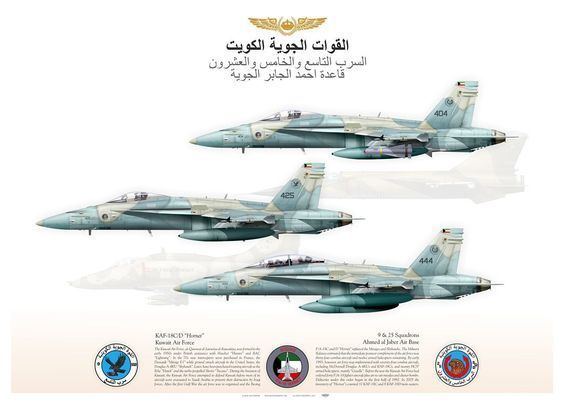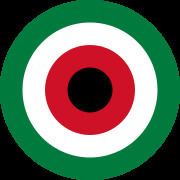Type Air Force Founded 1953 | Colors Green & Red Color Green & Red | |
 | ||
Active 1953; 64 years ago (1953) Size Approx. 5,000 personnel Garrison/HQ Abdullah Al-Mubarak Air Base Anniversaries National and Liberation Day (25 and 26 February) Motto الله والوطن والامير God, Country & The Emir Engagements Gulf War, Invasion of Kuwait Similar Kuwait Military Forces, Qatar Air Force, Royal Bahraini Air Force, Royal Air Force of Oman, United Arab Emirates | ||
The Kuwait Air Force (Arabic: القوات الجوية الكويتية Trans: al-Quwwat al-Jawwiya al-Kuwaitiya) is the air arm of the State of Kuwait. The Air Force headquarters is located at Abdullah Al-Mubarak Air Base, with the remaining forces stationed at Air Defense Brigades, Ali Al Salem Air Base and Ahmed Al Jaber Air Base. The Kuwait Air Force numbers approximately 5,000 officers and enlisted personnel.
Contents
- Rare kuwait air force c 17a departing newcastle airport kaf 343
- History
- Iraqi invasion
- Post Gulf War
- Tanker and cargo plane programs
- Air Defense program
- Transport and Attack helicopter program
- New combat fighters
- References

Rare kuwait air force c 17a departing newcastle airport kaf 343
History

The Kuwait Air Force was founded in 1953 by Field Marshal Sheikh Abdullah Mubarak Al-Sabah when the Directorate of Public Security Force split from the Kuwaiti Army; the new force was equipped with a number of Austers in different configurations and two de Havilland DH.104 Doves.|reason=Date of foundation has to be considered suspect, found a reliable source stating the first Kuwaiti pilot had his first solo flight while learning to fly, in 1954. Another source states that four Austers were delivered to the Kuwait Aero Club in March 1954, with no mention of military deliveries.
The Kuwait Air Force was expanded concurrently with the course of the British intervention during Operation Vantage that deterred Iraq from annexing Kuwait as one of its provinces. The first aircraft to enter KAF service were four Whirlwind helicopters and six BAC/Hunting Jet Provost T.51s. This support from the UK would remain in place for a long time and 1964 was known for the arrival of the first Hawker Hunters. These would later be joined by more examples in 1969. Two de Havilland Canada DHC-4 Caribou transports arrived in 1963. The transport capacity would later be improved by the acquisition of an ex-RAF Armstrong Whitworth AW.660 Argosy in 1969 and later, in 1971, by two Lockheed L-100-20 Hercules.

In the meantime the fighter force was given a boost by the procurement of 14 English Electric Lightnings that were delivered in the late 1960s. Twelve BAC Strikemasters were delivered in 1969.

Between 1968 and 1977 two Bell 206s operated in KAF service and from November 1969, eight Augusta Bell 205s were delivered, replacing the aging Whirlwinds. Only five years after the delivery of the Lightnings, the KAF decided it needed an aircraft with better serviceability; it had been using the Hunters and the Strikemasters in the interceptor and ground strike role, rather than the Lightnings. Finally in 1974 the Mirage F1 was selected as the new air defence fighter and a total of 27 Mirage F1CKs and seven Mirage F1BKs were ordered and delivered in two separate batches until 1983. The ground strike role would be filled in by the total of 36 Douglas (T)A-4KU Skyhawks that were ordered in 1974 and delivered during 1977. In addition, 24 SNIAS SA-342K Gazelles were delivered during the mid-1970s and 4 were subsequently passed on to the Police Air Wing. Four L-100-30 Hercules transport aircraft were delivered in 1983, replacing the shorter L-100-20 version of which only one survived (the other crashed in France). Also in 1983, twelve Hawk T64s were ordered to fill the gap that the KAF had in training capacity. In 1988 the Air Force was named al-Quwwat al-Jawwiya al-Kuwaitiya (Kuwait Air Force). The lead-in-fighter-trainer that was selected, the Shorts Tucano T.52, would only be delivered in 1995. They were earmarked for delivery in 1990 but due to the outbreak of the Gulf War, deliveries were postponed.
Iraqi invasion
The delay in Iraqi air attacks allowed the Kuwaiti planes to get airborne. Kuwaiti A-4 attacked Republican Guard divisions still moving toward Kuwait City.
The initial Iraqi attack on al-Jaber closed the runways due to presence of air scattered mines. The returning Mirage F-1 and A-4 landed and were serviced on the perimeter fence road. Only when Iraqi troops were right next to the base did attack sorties stop.
Coalition forces heavily bombed the two Kuwait air bases, reducing most of the facilities to rubble and destroying nearly all of the 50 hardened aircraft shelters. Coalition cluster bombs cratered the taxiways and the Iraqis had run a ripper across the runways every 200 feet to make them unusable.
Post Gulf War
In the immediate postwar air force staff was 1,000, with 34 combat aircraft and 12 armed helicopters. In two years staff numbered about 2,500, with 74 combat aircraft, including McDonnell Douglas A-4s and F-18s, and 20 armed helicopters. Four batteries of I-Hawk medium-range SAMs and most of the fleet of transport aircraft had been impounded by Iraq
After the Gulf War, the KAF underwent a reorganization, growing in quantity and quality:
Tanker and cargo plane programs
Lockheed Martin has received a $245 million contract from the U.S. Government for the Foreign Military Sale of 3 KC-130J tanker aircraft to Kuwait with an option for 3 more. The program will be managed by the U.S. Navy. The Kuwait Air Force's new KC-130Js will provide aerial refueling for its F/A-18 fleet and augment its current airlift fleet of three Lockheed Martin L-100s. Kuwait's KC-130Js also will perform air mobility, disaster relief and humanitarian missions throughout the world. Kuwait's first KC-130J delivery is scheduled for late 2013, with deliveries completed in early 2014. Using only wing and external tanks. In September 2010, Kuwait requested to purchase one Boeing C-17 followed shortly with an order for one more.
Air Defense program
The USA is to sell 60 Patriot (PAC-3) missiles, 20 launching stations, four radar systems and control stations, personnel training and training equipment, and spare parts to Kuwait in a deal worth an estimated $4.2 billion, The Department of Defense of the U.S. awarded Raytheon a $655.4 million, took the form of a firm-fixed-price, sole-source, foreign military sales contract to supply to the Kuwaiti military two PATRIOT fire units, plus associated spare parts. Delivery of the units is expected to take place by April 30, 2018, in June 23, 2016 Raytheon Co was awarded a $523 million fixed-price-incentive contract to modernize six Patriot fire units in Kuwait, the U.S. Defense Department said on Thursdays
Transport and Attack helicopter program
Kuwait purchased 24 AH-64D Apache Longbow attack helicopters and 30 EC725 Caracal transport helicopters 24 for the Air Force and 6 for the National Guard. the purchase is motivated by concerns about potential terrorist or foreign attacks. EC725 Caracal fleet will be used for combat search-and-rescue, naval operations, medical evacuation and military transportation. The helicopters will be operated by the Kuwait Air Force and National Guard.
New combat fighters
On September 12, 2015, the Eurofighter consortium revealed that the Eurofighter Typhoon had been selected by Kuwait to update its fleet with 28 new fighter jets. The deal is a consequence of US delay in approve sale of Super Hornets.
In September 2016 it was also announced that the sale of up to 40 Boeing F/A-18E/F Super Hornet had been submitted to the US Congress for approval. Deal for 40 planes valued at USD10.1 billion was signed off on November 2016. It seems there is closed order for 28 Boeing F/A-18E/F Super Hornets to Kuwait, with an option of up to 16 more.
